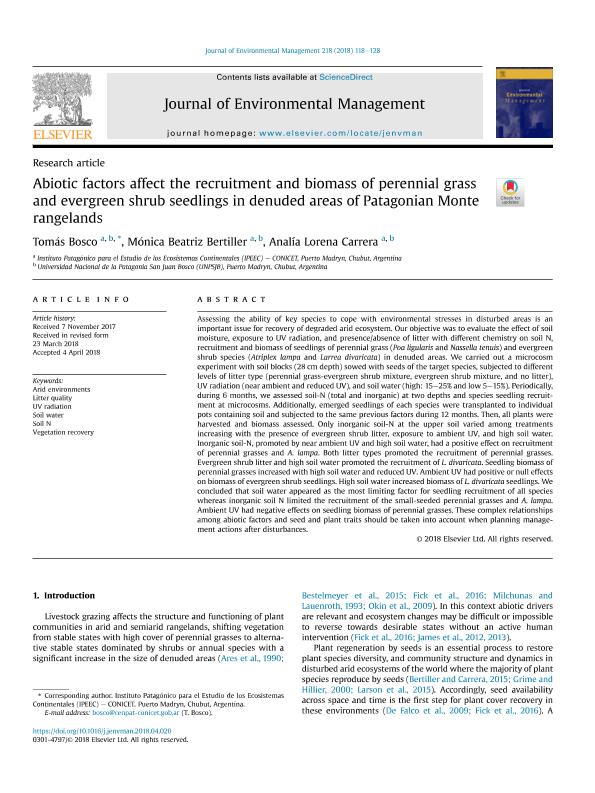Artículo
Abiotic factors affect the recruitment and biomass of perennial grass and evergreen shrub seedlings in denuded areas of Patagonian Monte rangelands
Fecha de publicación:
07/2018
Editorial:
Academic Press Ltd - Elsevier Science Ltd
Revista:
Journal of Environmental Management
ISSN:
0301-4797
Idioma:
Inglés
Tipo de recurso:
Artículo publicado
Clasificación temática:
Resumen
Assessing the ability of key species to cope with environmental stresses in disturbed areas is an important issue for recovery of degraded arid ecosystem. Our objective was to evaluate the effect of soil moisture, exposure to UV radiation, and presence/absence of litter with different chemistry on soil N, recruitment and biomass of seedlings of perennial grass (Poa ligularis and Nassella tenuis) and evergreen shrub species (Atriplex lampa and Larrea divaricata) in denuded areas. We carried out a microcosm experiment with soil blocks (28 cm depth) sowed with seeds of the target species, subjected to different levels of litter type (perennial grass-evergreen shrub mixture, evergreen shrub mixture, and no litter), UV radiation (near ambient and reduced UV), and soil water (high: 15–25% and low 5–15%). Periodically, during 6 months, we assessed soil-N (total and inorganic) at two depths and species seedling recruitment at microcosms. Additionally, emerged seedlings of each species were transplanted to individual pots containing soil and subjected to the same previous factors during 12 months. Then, all plants were harvested and biomass assessed. Only inorganic soil-N at the upper soil varied among treatments increasing with the presence of evergreen shrub litter, exposure to ambient UV, and high soil water. Inorganic soil-N, promoted by near ambient UV and high soil water, had a positive effect on recruitment of perennial grasses and A. lampa. Both litter types promoted the recruitment of perennial grasses. Evergreen shrub litter and high soil water promoted the recruitment of L. divaricata. Seedling biomass of perennial grasses increased with high soil water and reduced UV. Ambient UV had positive or null effects on biomass of evergreen shrub seedlings. High soil water increased biomass of L. divaricata seedlings. We concluded that soil water appeared as the most limiting factor for seedling recruitment of all species whereas inorganic soil N limited the recruitment of the small-seeded perennial grasses and A. lampa. Ambient UV had negative effects on seedling biomass of perennial grasses. These complex relationships among abiotic factors and seed and plant traits should be taken into account when planning management actions after disturbances.
Archivos asociados
Licencia
Identificadores
Colecciones
Articulos(IPEEC)
Articulos de INSTITUTO PATAGONICO PARA EL ESTUDIO DE LOS ECOSISTEMAS CONTINENTALES
Articulos de INSTITUTO PATAGONICO PARA EL ESTUDIO DE LOS ECOSISTEMAS CONTINENTALES
Citación
Bosco, Tomas; Bertiller, Monica Beatriz; Carrera, Analía Lorena; Abiotic factors affect the recruitment and biomass of perennial grass and evergreen shrub seedlings in denuded areas of Patagonian Monte rangelands; Academic Press Ltd - Elsevier Science Ltd; Journal of Environmental Management; 218; 7-2018; 118-128
Compartir
Altmétricas




